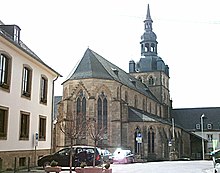Schweinstaler sandstone

The Schweinstaler sandstone , also called Schopper sandstone , is quarried in the Pfalz in Schweinstal near Schopp near Landstuhl in Rhineland-Palatinate . It was created in the middle red sandstone .
Mineralogy and color
This sandstone is quartz-bonded, its color is ocher and pale red to deep red. The red color is caused by an iron oxide hematite . The rock consists of 48 percent quartz , 45 percent rock fragments and 6 percent feldspar . The grain size ranges from 0.2 to 0.7 millimeters.
use
Schweinstaler sandstone is very good to good weather resistance. Its weathering behavior depends on the particular rock layer. Only when this sandstone has been exposed to weathering for a long time does it show loosening and sanding. The upper layer in the quarry is about 4.50 meters thick, so it is possible to extract large-format workpieces. The mined rock is of building block quality. This sandstone was mainly used for solid buildings, bricks, bridges, window and door frames as well as stairs , facades, tombs and in stone carving .
Buildings made of this sandstone are, for example, the Trippstadt Castle or the Benedictine Abbey in Tholey . It was also used in stone restoration work at the State Chancellery in Saarbrücken, the Palais Lüder. Numerous modern buildings were clad with Schweinstaler sandstone. a. the Heilbronn public prosecutor's office , the Kreissparkasse Kaiserslautern and the administration building in Heltersberg . Furthermore, numerous stone art objects on the sculpture trail in Rhineland-Palatinate have been carved out of Schweinstal sandstone.
See also
literature
- Wolf-Dieter Grimm: picture atlas of important monument rocks of the Federal Republic of Germany. Published by the Bavarian State Office for Monument Preservation, Lipp-Verlag, Munich 1990, ISBN 3-87490-535-7 .
Web links
- Sculpture path in Rhineland-Palatinate with images of sculptures made of Schweinstaler sandstone
- Sculpture by Martin Schöneich with a ball made of Schweinstaler sandstone
Individual proof
- ^ Grimm: Monument Atlas of Important Monument Stones. Rock no.104 (see literature)
Coordinates: 49 ° 22 ′ 48.5 " N , 7 ° 40 ′ 35.8" E

